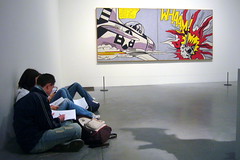I wrote an opinion piece in the Art of England (issue 77, January 2011) on the issue of artistic plagiarism called “On Learning to Steal”. I start by musing on the usefulness of students learning art by copying works in art galleries. You know the story, littered around the floor are art students busily copying, sketching some work or other. As I note in the article, they seem more like a piece of performance art to a failing art education system, than serious learning. I make the point that this only encourages further theft: “bad artists copy, good artists steal”. They are learning how to steal.
But more worrying, of course, is artistic plagiarism, and I draw attention to a recent high-profile example in Australia. I come down hard and negatively toward artists who maintain an atelier where their job is signing finished works of art (I call them signaturists). I observe that these artists themselves sense this is a con, otherwise, why would one well-known artist preface recent work by saying the work was done personally.
Plagiarism in all its forms is not to be trifled with. In the visual arts, copying is rife, not helped by the ease of cut-and-paste off the internet.
Nevertheless, we must be vigilant of artists who fail, as one artist put it, to adequately reference their sources.
Should art have footnotes?
Want to know more?
An overview of artistic plagiarism by Denis Dutton

